Book contents
- Frontmatter
- Contents
- Foreword
- Acknowledgements
- Introduction
- Section I Historical Antecedents and the Question of Nationality
- Section II The Meeting Ground: Indians and Chinese in Southeast Asia
- Section III Indians in China and Chinese in India
- Section IV Across the Globe: Indian and Chinese Diasporas
- 15 Overseas Indian and Chinese Communities in Film: Defining Identities through Popular Hindi Film and Transnational Chinese and Indian Films, 1990s Onwards
- 16 The “Other” NRIs: The Case of Low-Wage Indian Migrants in the Gulf
- Postscript Shifting Worlds and Changing Identities: The Reshaping of the Chinese-Indian Communities in India after the 1962 “Sino-Indian Incident”
- List of Contributors
- Index
15 - Overseas Indian and Chinese Communities in Film: Defining Identities through Popular Hindi Film and Transnational Chinese and Indian Films, 1990s Onwards
from Section IV - Across the Globe: Indian and Chinese Diasporas
Published online by Cambridge University Press: 05 December 2015
- Frontmatter
- Contents
- Foreword
- Acknowledgements
- Introduction
- Section I Historical Antecedents and the Question of Nationality
- Section II The Meeting Ground: Indians and Chinese in Southeast Asia
- Section III Indians in China and Chinese in India
- Section IV Across the Globe: Indian and Chinese Diasporas
- 15 Overseas Indian and Chinese Communities in Film: Defining Identities through Popular Hindi Film and Transnational Chinese and Indian Films, 1990s Onwards
- 16 The “Other” NRIs: The Case of Low-Wage Indian Migrants in the Gulf
- Postscript Shifting Worlds and Changing Identities: The Reshaping of the Chinese-Indian Communities in India after the 1962 “Sino-Indian Incident”
- List of Contributors
- Index
Summary
The Diasporic Communities and the Films
The global population of Indians overseas is estimated at over 17 million. Of these over 2.5 million are estimated to be in the United States (constituting 0.92 per cent of the US population), while Singapore's Indian population constitutes officially 9.2 per cent of the nation's population, including citizens, permanent residents (over 330,000) and expatriate workers (over 100,000). The global population of Chinese overseas is estimated at 40 million, over twice the number of overseas Indians. An estimated 30 million are living in Southeast Asia, while in the United States persons of Chinese descent number approximately 3.6 million, comprising 1.2 per cent of the US population.
Both these populations were subject to the global demands for migrant labour in the nineteenth century, when the colonial powers took workers as indentured labour to other colonies – to work on plantations and in mines, and in some cases to assist in junior administrative posts. Many of these migrant workers did not return, making these new lands their home. Political and economic instabilities of the post-colonial era created the next wave of migration from both countries. It is the latter group of migrants during the last six decades who have kept close ties with the motherland, particularly in the Indian case. The communities of Indians and Chinese overseas, old and recent, provide both the subject matter as well as the audiences for films that depict the Indian and Chinese diasporic communities.
Members of diasporic communities often struggle with their identities. Are they Indian, Indian-American, or American, Chinese, American-Chinese, Fijian, Fijian-Indian, Canadian, Canadian-Chinese, and so on? What makes a person living in North America, for instance, Indian or Chinese? Is it their parentage, their values, the food they eat, the language they speak (or are expected to speak at home)? Is it in their blood? Is it their ethnicity? Is it their culture? Are they American in their homeland, and Indian or Chinese in North America? Are they foreign everywhere? Much scholarly work has been done on multicultural identities in overseas communities.
- Type
- Chapter
- Information
- Indian and Chinese Immigrant CommunitiesComparative Perspectives, pp. 235 - 256Publisher: Anthem PressPrint publication year: 2015



